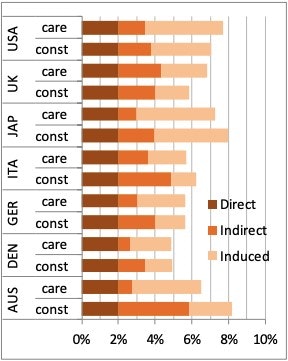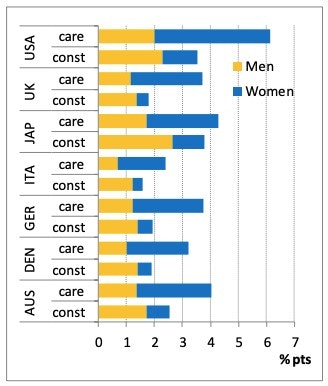Tackling gender inequality through investment in social infrastructure

The UK government’s response to the financial crisis brought disastrous economic consequences and unnecessary hardship. Austerity policies have hit women, BAME people and the poorest the hardest, while failing the government’s goal of reducing public debt in the first place. In this guest blog, Sara Reis of The UK Women’s Budget Group argues that an alternative approach of investment in social infrastructure is the way forward.
The response of the UK government to the global 2008 Financial Crisis was one of austerity policies, Quantitative Easing (QE) and bank bail-outs. It was a response rooted in the goal to reduce the deficit and public debt to ‘sustainable levels’.
None of these approaches worked. Take austerity measures. Reductions in state spending for local authorities, public services and welfare benefits took a huge toll on individuals and families. They also increased inequality. Households on the bottom decile of the income chart will see their living standards cut by an average of 21% annually in 2020, more than five times as much as the cut to living standards for those in the top decile. Women have borne the brunt of austerity measures, with the House of Commons Library calculating that 86% of burden of austerity has fallen on women. This is to do with the ‘triple whammy’ of benefit claiming, employment and public service use patterns: women are more likely to be welfare recipients on their own right or on behalf of someone else (e.g. child benefit), they are the majority of people working in the public sector (which was affected by lay-offs, wage cuts and wage freezes), and women are also more likely to use public services than men. This triple whammy is a result of unpaid care work being disproportionately shouldered by women.
Ethnicity also intersects with gender and class when looking at who has borne the brunt of austerity. Low-income women from BME backgrounds were the worst hit by public spending cuts since 2010.
Austerity measures did not just impoverish people who were already struggling financially and increased inequality – they were also a disaster in economic terms. Economic growth since 2010 has been less £100bn than would otherwise have been if the government had eschewed public spending cuts.
Beyond austerity, the government’s strategy to deal with the Financial Crisis of 2008 was to inject money into the financial system through Quantitative Easing. QE saw the Bank of England buying £445 billion worth of financial assets in an effort to stimulate spending and investment to trigger growth. This in fact gave private banks more money to lend – but it did not trickle down to the economy in the form of loans to businesses or industry. Instead, banks used it to invest in housing and financial assets, helping to inflate the property and financial markets. Inequality rose, with wealthiest individuals seeing their assets’ value rise and the poorest seeing their income cut through unemployment, precarious jobs, and cuts to benefits and public services.
In the aftermath of the crisis, and as an attempt to stabilise the financial system, the UK government, as many other governments around the world, bought shares in struggling banks, effectively taking them into public ownership. £50bn were spent in this way. The Royal Bank of Scotland was the most prominent case. The rushed plans to return it to private ownership by 2024 seem to be not only an unsound financial decision (the OBR estimates a loss of £28.5bn) but also to constitute a lost opportunity to improve the banking system.
An alternative approach – public investment in social infrastructure
This three-pronged strategy was a disaster for the economy and for equality. The Government has announced an end to austerity; but the benefit freeze is still in place and public services are still funded at lower levels in real terms than before the crisis. Much like Positive Money, the Women’s Budget Group advocates for a radically different strategy, a policy focused on the state investing money in the real economy. Instead of continuing its QE strategy, the Government should invest in adequate welfare benefits that sufficiently support people in hardship and function as a true social security net, improving people’s financial security and spending capacity. It should also invest in high-quality adequately-funded public services that raise people’s living standards.
The Women’s Budget Group has long advocated for a large investment in social infrastructure, in services that allow people to receive the high-quality care they need and deserve. This means investing in more nursery places, more services for disabled people and more adult social care services. Research from the WBG has estimated that investing 2% of GDP in such social infrastructure in the UK would create 1.5 million jobs (compared to 750,000 for an equivalent investment in construction), with almost as many jobs created for men as investing in construction industries and up to four times as many jobs for women. Investing in care industries is more effective in reducing public deficits and debt than austerity policies and it would boost employment, earnings, economic growth and foster gender equality.
Figure 1. Contribution of direct, indirect and induced effects to GDP growth (of investing 2% of GDP in care economy vs construction)

Source: WBG (2016) Investing in the Care Economy to boost employment and gender equality
Figure 2: Contribution of men’s and women’s employment to the rise in employment rates by industry and country (of investing 2% of GDP in the care economy)

Source: WBG (2016) Investing in the Care Economy to boost employment and gender equality.
More importantly, it would also result in a healthier, happier and better-educated population.
Since 2010, the UK government’s response to the financial crisis and subsequent economic downturn was to cut public spending to reduce public debt. This has had disastrous consequences in terms of increased hardship and inequality, with women and the poorest being worse hit, while failing the government’s own goal of reducing public debt in the first place. Based on research comparing austerity and investment in seven countries, the Women’s Budget Group argues that an alternative approach of investment in social infrastructure is the way forward.